Composing with Harmonics
Tools for Composers
Composers will find here information about the “instrument” overtone singing and templates that simplify composing.
If questions remain unanswered, I will be happy to support. I am delighted with every commitment to this new instrument. Feel free to contact me.
Melody or Timbre?
For western overtone singing there are two fundamentally different compositional approaches: Melody overtones or timbre overtones.
Nori Jacoby – Jerusalem Dream – Scene II Perfumed with Myrrh (part)
Melodies are sung with overtone singing technique. They sound like a spherical mixture of glass harp and flute. The sound material is the natural harmonic series. Natural melodies have a calming and meditative effect.
Melody overtones are to be considered as a second instrument in composition. Both overtone and fundamental melodies simultaneously enable real polyphony – a singer can sing in a canon with himself. Flowing transitions into vowel overtones and normal singing are possible.
Timbres are sung with vowel harmonics. It is little known that timbre can be composed down to the last detail. Vowel harmonics are the link between speech and overtone singing (see choral phonetics). Synchronous timbre shifts are a new stylistic element for choral music.
Interesting sound scape effects result when a choir sings several overtone melodies in a jumble. The effect is often perceived as a lively synthesizer sound (cf. Glenn Keiles’ film music to “The Life of Buddha”, or Bernat Vivancos’ “Obriu-me els llavis, Senyor”). Smooth transitions from speech to overtone singing are also possible.
Tessitura
 The range of overtone singing varies depending on the singing technique. The NG technique is suitable for lower harmonics, the L, R and J techniques for higher harmonics. There are two limits to overtone singing: The absolute limit of possible frequencies, and the relative limit of position in the harmonic series.
The range of overtone singing varies depending on the singing technique. The NG technique is suitable for lower harmonics, the L, R and J techniques for higher harmonics. There are two limits to overtone singing: The absolute limit of possible frequencies, and the relative limit of position in the harmonic series.
Frequency limits: Physiologically, harmonics can only be sung from approx. A4 to D7 (440 to 2500 Hz). NG technique: approx. A4 to B5. L/R/J technique: approx. E5 to D7. The limits are set by the resonance frequencies, i.e. by the shape limitations of the vocal tract.
Limits of the harmonic series: At the same time, only the harmonics 3 to 16 can be used for melodies. For most singers, clear overtone melodies are only possible up to the 12th, a few up to the 16th harmonic. In Tuva and Mongolia, they don’t sing beyond the 13th harmonic. Depending on the desired timbre, harmonics of up to 20 can be sung, which then have a strong fundamental part in the sound. The upper limit is caused by the narrow distances between partials above 12. The 2nd and 1st harmonics are not heard as separate overtones.
The combination of both results in an individual overtone range for each keynote.

For my part, I set G2 as the lower limit of the fundamental. On G2, clearly isolated overtones can be sung. The upper limit is C5, on which the soprano still can sing the harmonics 3, 4 and 5. With G5 the tone is reached on which only and just the 3rd harmonic (D7) could be sung.
Theoretically, 7 overtones could be sung on C2, provided the singer applies enough vocal chord pressure in this low register to produce enough loud overtones. C2 is an extreme position that does not occur in any composition known to me.
The comfort zone, which many Western overtone singers find pleasantly singable, is marked in green. This area is suitable, for example, for choir compositions that are also mastered by experienced amateur choirs. Professional singers can occasionally sing beyond the specified range. Since there are only a few professional overtone singers, more complex solo works will be adapted individually.
The ambitus of the harmonics is almost the same for all registers. Female voices are about 2 to 3 semitones higher than men due to their slightly shorter vocal tract. However, the fundamental ranges are very different and much smaller than the normal singing range.
- The lowest singable overtone is either E5 or the 3rd partial, whichever is higher.
- The highest singable overtone is either D7 or the 16th partial, whichever is lower.
Singable Harmonics in Notes
An overview of all singable harmonics in sheet music. From G2 in bass to C5 in soprano, all harmonics suitable for melody formation are notated for L, R and J techniques. The comfort zone is green again.
Diagram of Overtones
This scheme summarizes all essential information about the connection between pitch and overtone singing. In addition to the singing tones (lower keyboard) from B1 to F6, the harmonic series can be read vertically upwards. The pitches that can be achieved with overtone singing are underlaid in grey (NG technique) or orange (L, R, J technique). Overtones that are in an overtone area and simultaneously between the 3rd and 16th harmonic can be easily sung.
The Overtone Slide
The overtone slider is the predecessor of the “Overtone Analyzer” software. It consists of the piano scheme and the harmonics slider. It contains all essential information about the range of overtone singing.
The piano scheme shows the fundamental range of the vocal registers, the range of the resonance frequencies in the vocal tract and the range of the singable harmonics (the range of the double resonances in the overtone technique). If the harmonics slider is placed on top the piano, the singable overtones can be read off immediately.
The harmonics slider represents the sound produced by the larynx, the chord of partial tones that make up the voice. This chord interacts with the resonances represented in the piano scheme. The harmonics slider is placed with its keynote on the singing note and the singable overtones can then be read.
Finding Fundamentals for an Overtone
Overtone Analyzer makes it extremely easy to find all fundamental tones for any overtone: The undertone series of an overtone contains all the fundamental tones with which this overtone can be produced. All undertones in the range of the desired pitch can be used as the keynote for the targeted overtone.
Example 1: Assuming that C6 is to be sung as an overtone by a bass in a composition. Each subharmonic of C6 can be used as the fundamental if it is within the vocal range of the singer. The range of a bass is between approx. E2 and E4, within which the 4th to 12th subharmonics of the target harmonics C6 can be found, i.e. a bass can reach the desired C6 as overtone from the fundamental notes F2, F#2, G2#, G2#, A2#, C3, D3, F3, G#3 or C4.
Example 2: Let us assume that C6 is to be sung by a soprano as an overtone in a composition. Each subharmonic of C6 can be used as the fundamental if it is within the vocal range of the singer. The soprano has a tonal range of approx. A3 to E6 within which the 2nd to 4th subharmonics of C6 are located. The 2nd subharmonic is omitted as a possible fundamental, because C6 would not be perceived as the 2nd partial (see section ” Range ” above). Thus only the basic notes C4 and F4 are available to the soprano for C6 as overtone.
Crossing Borders
G#7 is the highest overtone I’ve heard. It is produced by the throat singing masters Hosoo and Steve Sklar. Throat singing sounds louder, higher and more pressed than western overtone singing. The upper limit of the 2nd resonance frequency is D7, but since the whistle harmonics are produced by a double resonance of the 2nd and 3rd resonance frequencies, a different technique is probably used by throat singers in the highest register. I suspect that a double resonance of the 3rd and 4th resonance frequency is generated.
Few experts can reach the 24th partial. The interval to the 23rd partial is very narrow, only about 2/3 semitone. If the 24th partial is to be sung and D7 is not exceeded, G2 (98 Hz) or lower must be selected as the fundamental. You then have the partials 5 to 24 available (the 4th partial G4 is too low for overtone singing).
Women Only Use Half the Harmonic
Men and women have almost identical overtone ranges because the vocal tract is much less different than the vocal pitch. The voices are an octave apart on average. With high voices the overtones are less dense, so there are fewer overtones available for overtone singing. Man and woman both have an average overtone range from A4 to D7, but the number of overtones is different in this interval.
While a soprano (above) can sing the harmonics of the 2nd to 4th octaves on D4, i. e. the harmonics 3 to 8, a bass/tenor (below) can sing the harmonics 3 to 16 on D3. Both have the same frequency range of overtones A4 to D7, but a male voices can sing twice as many overtones as a female voice in this range, so men have a wider selection of steps. Sopranos have to change their fundamental tone more often to sing melodies with narrow intervals.
Pitch & Ambitus
C2 as fundamental: From C2 you would have many overtones available, but from the 16th partial the intervals become so narrow that you can hardly separate them. Since E5 is the lowest singable overtone (L-technique), one can only sing upwards from the 10th partial of C2. C2 is usually too low for normal singers to get enough sound pressure into the overtones.
A2 as fundamental: On A2 you can already sing up to 11 partials.
C3 as fundamental: On the middle register C3 of the tenor there are 12 possible notes.
C4 as fundamental: On C4, soprano, 7 partials can still be sung, but in the range of the larger intervals. The smallest interval in the harmonic series of C4 is the Pythagorean greater tone between C7 and D7.
| Teilton | Bass | Bariton | Tenor | Sopran |
|---|---|---|---|---|
| 16 | c3 | a3 | c4 | |
| 15 | h2 | g#3 | h3 | |
| 14 | a#3↓ | g3↓ | a#3↓ | |
| 13 | g#2↑ | f3↑ | g#3↑ | |
| 12 | g2 | e3 | g3 | |
| 11 | f#2↓ | d#3↓ | f#3↓ | |
| 10 | e2 | c#2 | e3 | |
| 9 | h2 | d3 | d4 | |
| 8 | a2 | c3 | c4 | |
| 7 | g2↓ | a#2↓ | a#3↓ | |
| 6 | e2 | g2 | g3 | |
| 5 | e2 | e3 | ||
| 4 | c3 | |||
| 3 | g2 | |||
| 2 | ||||
| 1 | C | A | c | c1 |


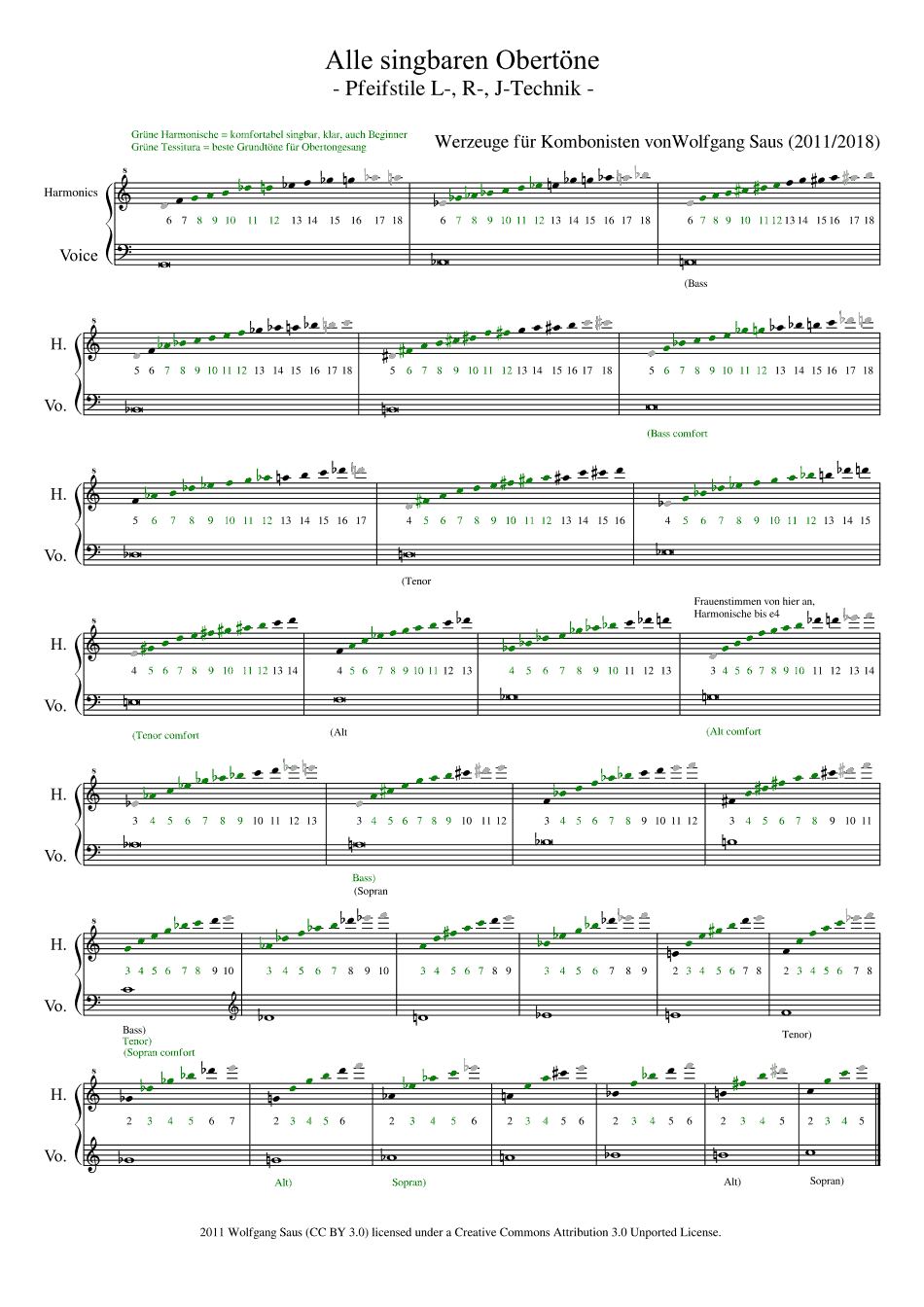
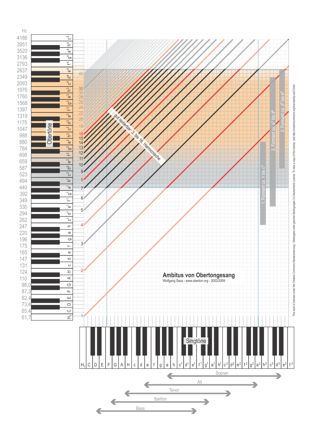
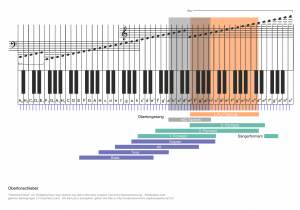
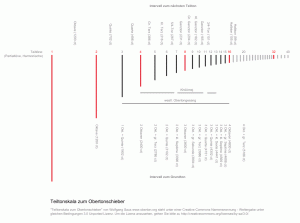
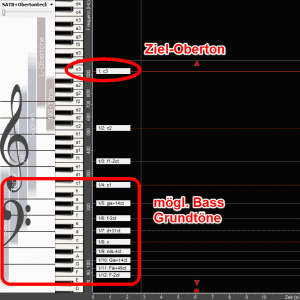
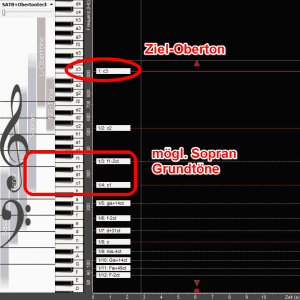
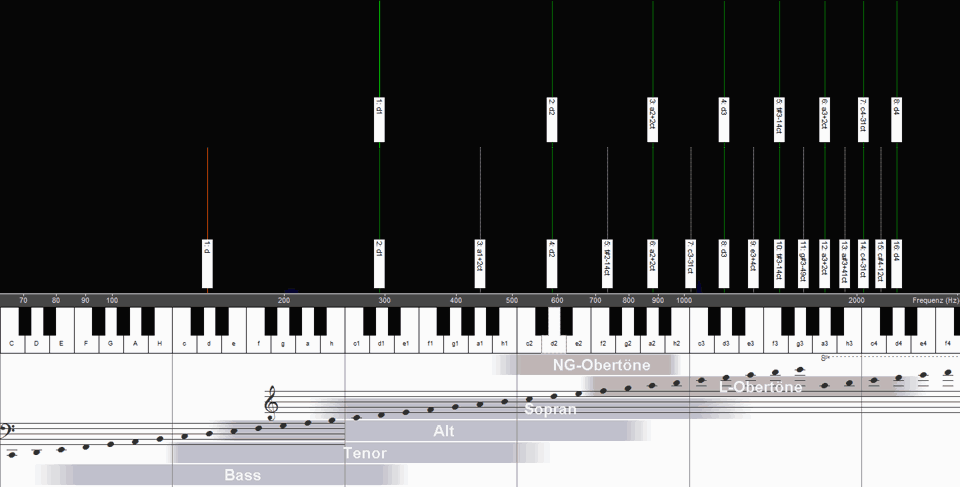

Hi Wolfgang, sorry I didn’t get a notification that you replied to me. I will try to find the recording or record a new one when I have some time and send them to you. Just be prepared, I don’t make these notes sound too pretty. ;)
I’m curious about what you mean by “D8 is above the 5th resonance frequency” – could you explain a little more?
Hi Bazyli, regarding your question about D8: overtone singing is based on the 2nd and 3rd resonant frequencies. The upper limit for this for men is about 2.7 kHz, which corresponds to E7. D8 has 4.7 kHz, so it is far above the usual overtone singing resonances, even above the resonances of the voice box itself. Therefore I am interested in the recordings, to see how you do it.
Hi Wolfgang! Your website is an amazing resource. Thank you so much for these resources.
I was curious about the upper limits, and started fooling around with overtones on top of very high fundamentals – to my surprise the 5th harmonic on top of B4 is easy and loud (last one you list in your reference), but I was able to pull off a clear 8th and then a recognisable 9th and 10th. Would require a bit more training to sustain, but I got there – that’s as high as E8 (5391 Hz). And I’m definitely no master, I only started overtone singing a few months ago.
When I tried starting from an even higher fundamental, D#5 (the highest comfortable pitch I could make today), I get a clear 6th harmonic (A#7), up to an 8 (D#8) that’s a bit faint. Note that at this point my mouth has to be so tiny, I’m basically keeping my teeth closed, tongue pressing against them, and moving the back part of the tongue towards the upper palate very slightly each time I go up to the next harmonic. Because it’s such a high fundamental, the overtones come through audibly. Not sure if there’s musical application for this, but it’s anatomically possible – give it a try!
Just tried the opposite, lowest note and going up with overtones. It’s true that with normal throat position very high overtones are subdued by the fundamental, but when combined with the Khöömei throat tension they become much clearer. I was able to go up to around 24th – not sure how useful that is musically, I was able to sing melodies that include harmonics above 16th. It’s actually somewhat easier to sing, because the notes are spaced closer together so there is more to choose from .
With Khöömei the overtones not only are louder in general, but there’s a shift around 20th when they become even stronger:
https://imgur.com/a/ZrM3rJl
Hi Bazyli,
thank you for your exciting contribution. A spectrogram or better still a sound file of your harmonics up to D8 would interest me very much. I am always looking for innovation. The highest harmonics I have heard so far from Khöömii masters go up to G#7. D8 is above the 5th resonance frequency and would therefore be controlled with previously unknown resonances. Could you send me recordings?